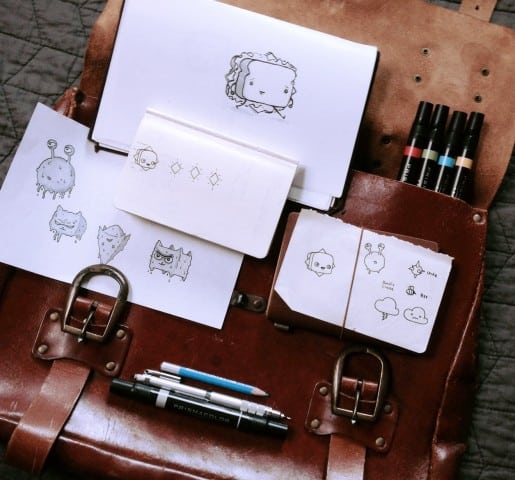I recently sat down with Jake Fleming, the game designer behind Grilly the Cheese, Hot Shot Santa and Don’t Eat People. Jake was kind enough to give us a glimpse into his process and show us a bit of his work.
MS: Alright Jake, let’s start with you telling us a bit about how you come up with game ideas?
JF: Typically our ideas come from conversations over lunch. We all have full time jobs and it’s difficult to get together regularly, especially since Corey lives in Portland, and Mike and I live in Chicago. When Mike and I can get away from developing software at Appiphony we’re usually talking about games – whether it’s how to make the current game we’re working on better or what the next one will be about. These conversations typically happen over lunch, a lot of our ideas get driven by our appetites. Hence, Grilly The Cheese and our most recent release, Don’t Eat People.
MS: Love the names you come up with. Once you guys have a good game idea, how do you come up with the characters and bring them to life?
JF: When I’m coming up with characters I sketch a ton and usually hate most of it. Once I finally find a direction I like I enlist my better half, Rachel, to take a crack at some concept art. I’ll try different proportions and emotions to see how the character will work in various situations. I try not to get married to any one idea when approaching a character and leave myself open to other’s input.
I start creating a version in Adobe Illustrator of the character at the smallest scale I want it to appear in the game. I want to make sure the emotion and detail I sketched beforehand is going to come through at smaller sizes. This is usually where details get shaved off and the character’s most important features start to shine and get feedback.
I’ll then take a crack at some animation. If it’s simple, I’ll just do it in Illustrator on a few artboards. If it’s more complicated, I might take the Adobe Illustrator assets I created into Adobe After Effects and animate it there.
Grilly the Cheese hopping animation
I’ve found that After Effects can be really powerful as well as versatile, when trying to make your character feel ‘alive’. I’ve tried other programs like Flash, but After Effects is by far my favorite.
Testing out using After Effects with sprite animation.
MS: So how do you test your game ideas to make sure they will actually be fun and engaging?
JF: When the three of us feel good about any particular idea, we start developing a prototype with basic colored shapes to show to friends, family, and even strangers. We can get a sense for just how fun our core game mechanic can be without fancy art and music clouding the user’s judgement. Showing the game to everyone who will listen and quickly iterating based on their feedback is how we know when we want to take an idea to the next level. There’s a fine line there though. We’re always careful not to take every piece of feedback to heart. If you’re shy, don’t have friends, or think strangers are scary you can use other tools like TestFlight to get your game out there to people in its early stages.
MS: Can you tell us about the team you work with when building games?
JF: Right now, the team consists of Corey Warning who does most of the sounds & music as well as a huge portion of the QA and sort of plays the project manager role. Mike Blazek is the master of all things code. Without Mike I’m not super sure what we’d do. He works insanely fast and can solve complex problems that leave my brain hurting afterward. Me, I draw cute things and make them move. I also do some of the music in the games.
MS: Alright, that’s it. Thanks Jake!
If you’re interested in learning more about Jake’s game design process then check out his Mobile Game Design course on Treehouse. In the course he designs a fun game called Space Cat who’s mission is to rid the world of pesky K9s. We then took those designs and created a iOS Game Development course using Sprite Kit. We now have two courses for you to get started with game development career.
